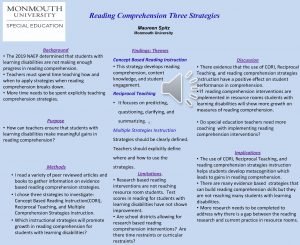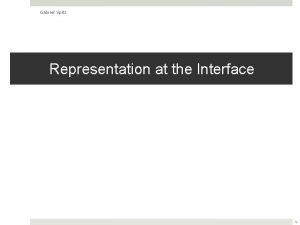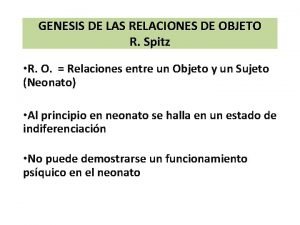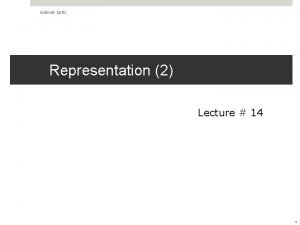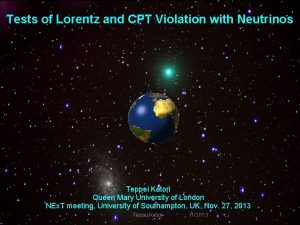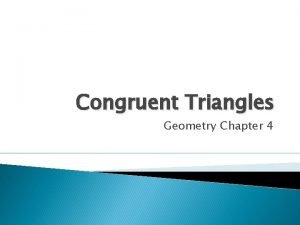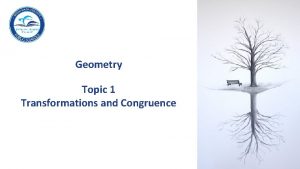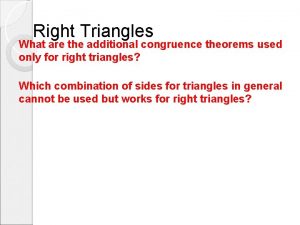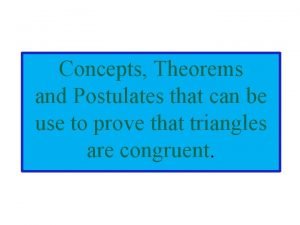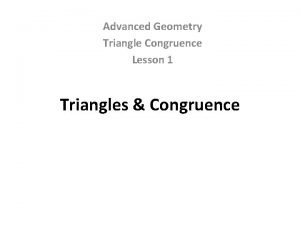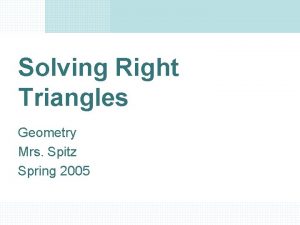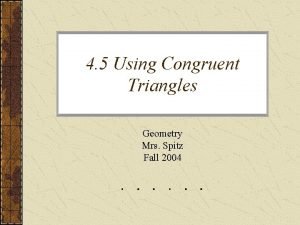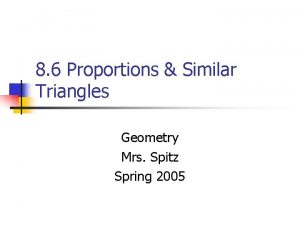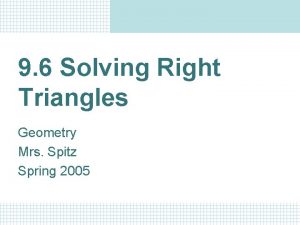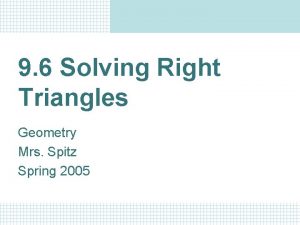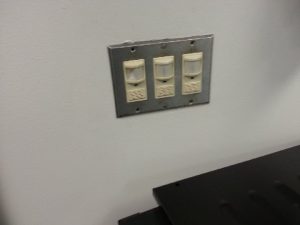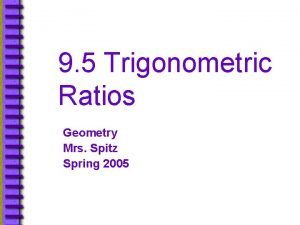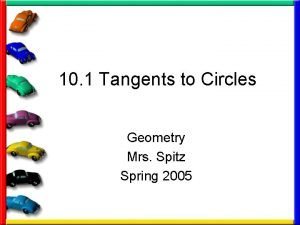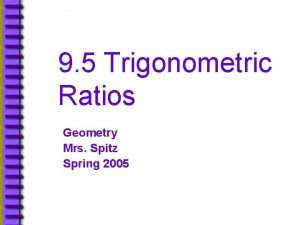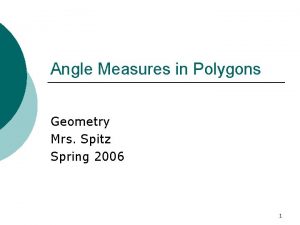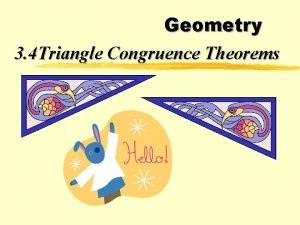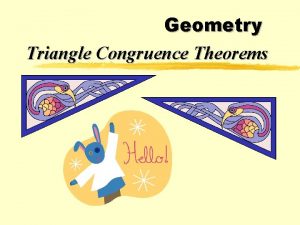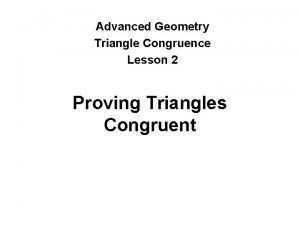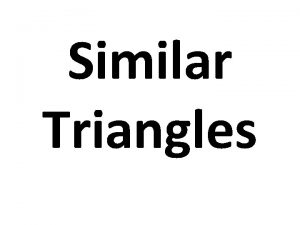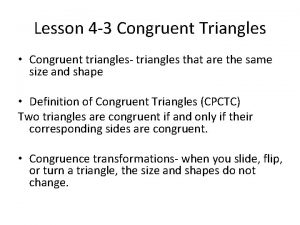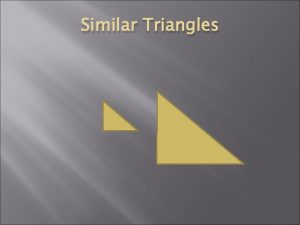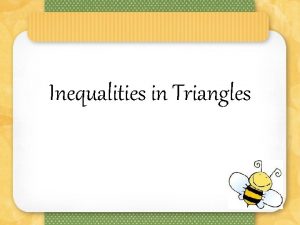4 2 Congruence Triangles Geometry Mrs Spitz Fall
























- Slides: 24

4. 2 Congruence & Triangles Geometry Mrs. Spitz Fall 2005

Objectives: • Identify congruent figures and corresponding parts • Prove that two triangles are congruent

4. 2 Work • 4. 2 pgs. 205 -207 #4 -35 (Skip 22, 23, 34) Be prepared next time we meet to draw on the board for participation points. • Quiz 4. 2 on page 210 to review for quiz next time we meet.

Identifying congruent figures • Two geometric figures are congruent if they have exactly the same size and NOT CONGRUENT shape. CONGRUENT

Congruency • When two figures are congruent, there is a correspondence between their angles and sides such that corresponding angles are congruent and corresponding sides are congruent.

Triangles Corresponding angles A ≅ P B ≅ Q C ≅ R Corresponding Sides AB ≅ PQ BC ≅ QR CA ≅ RP B A Q CP R

How do you write a congruence statement? • There is more than one way to write a congruence statement, but it is important to list the corresponding angles in the same order. Normally you would write ∆ABC ≅ ∆PQR, but you can also write that ∆BCA ≅ ∆QRP

Ex. 1 Naming congruent parts • The triangles are congruent. Write a congruence statement. Identify all parts of congruent corresponding parts.

Ex. 1 Naming congruent parts • The diagram indicates that ∆DEF ≅ ∆RST. The congruent angles and sides are as follows: • Angles: D≅ R, E ≅ S, F ≅ T • Sides DE ≅ RS, EF ≅ ST, FD ≅ TR

Ex. 2 Using properties of congruent figures • In the diagram • You know that LM ≅ NPLM ≅ EFGH GH. So, LM = GH. • A. Find the value of x. 8 = 2 x – 3 11 = 2 x 11/2 = x 8 m 110° (2 x - 3) m 72° 87° 10 m (7 y+9)°

Ex. 2 Using properties of congruent figures • In the diagram • You know that N ≅ NPLM ≅ EFGH E. So, m N = m E. • B. Find the value of y 72°= (7 y + 9)° 63 = 7 y 9=y 8 m 110° (2 x - 3) m 72° 87° 10 m (7 y+9)°

Third Angles Theorem • If any two angles of one triangle are congruent to two angles of another triangle, then the third angles are also congruent. • If A ≅ D and B ≅ E, then C ≅ F.

Ex. 3 Using the Third Angles Theorem • Find the value of x. 55° 65° • In the diagram, N ≅ R and L ≅ S. From the Third Angles Theorem, you know that (2 x + 30)° M ≅ T. So m M = m T. From the Triangle Sum Theorem, m M=180° - 55° - 65° = 60° • m M = m T 60° = (2 x + 30)° 30 = 2 x 15 = x

• • Ex. 4 Proving Triangles are congruent Decide whether the triangles are congruent. Justify your reasoning. From the diagram, you are given that all three pairs of corresponding sides are congruent. RP ≅ MN, PQ ≅ NQ, QR ≅ QM. Because P and N have the same measure, P ≅ N. By vertical angles theorem, you know that PQR ≅ NQM. By the Third Angles Theorem, R ≅ M. So all three pairs of corresponding sides and all three pairs of corresponding angles are congruent. By the definition of congruent triangles, ∆PQR ≅ ∆NQM. 92°

Ex. 5 Proving two triangles are congruent • The diagram represents triangular stamps. Prove that ∆AEB≅∆DEC. • Given: AB║DC, AB≅DC. E is the midpoint of BC and AD. • Prove ∆AEB ≅∆DEC • Plan for proof: Use the fact that AEB and DEC are vertical angles to show that those angles are congruent. Use the fact that BC intersects parallel segment AB and DC to identify other pairs of angles that are congruent.

Proof: Statements: Given: AB║DC, AB≅DC. E is the midpoint of BC and AD. Prove ∆AEB ≅∆DEC 1. AB║DC, AB≅DC 2. EAB ≅ EDC, ABE ≅ DCE 3. AEB ≅ DEC 4. E is the midpoint of AD, E is the midpoint of BC. 5. AE ≅ DE, BE ≅ CE 6. ∆AEB ≅ ∆DEC Reasons:

Proof: Statements: Reasons: 1. AB║DC, AB≅DC 1. Given 2. EAB ≅ EDC, ABE ≅ DCE 3. AEB ≅ DEC 4. E is the midpoint of AD, E is the midpoint of BC. 5. AE ≅ DE, BE ≅ CE 6. ∆AEB ≅ ∆DEC

Proof: Statements: Reasons: 1. AB║DC, AB≅DC 1. Given 2. EAB ≅ EDC, ABE ≅ DCE 3. AEB ≅ DEC 4. E is the midpoint of AD, E is the midpoint of BC. 5. AE ≅ DE, BE ≅ CE 2. Alternate interior angles theorem 6. ∆AEB ≅ ∆DEC

Proof: Statements: Reasons: 1. AB║DC, AB≅DC 1. Given 2. EAB ≅ EDC, ABE ≅ DCE 3. AEB ≅ DEC 4. E is the midpoint of AD, E is the midpoint of BC. 5. AE ≅ DE, BE ≅ CE 2. Alternate interior angles theorem 3. Vertical angles theorem 6. ∆AEB ≅ ∆DEC

Proof: Statements: Reasons: 1. AB║DC, AB≅DC 1. Given 2. EAB ≅ EDC, ABE ≅ DCE 3. AEB ≅ DEC 4. E is the midpoint of AD, E is the midpoint of BC. 5. AE ≅ DE, BE ≅ CE 2. Alternate interior angles theorem 3. Vertical angles theorem 4. Given 6. ∆AEB ≅ ∆DEC

Proof: Statements: Reasons: 1. AB║DC, AB≅DC 1. Given 2. EAB ≅ EDC, ABE ≅ DCE 3. AEB ≅ DEC 4. E is the midpoint of AD, E is the midpoint of BC. 5. AE ≅ DE, BE ≅ CE 2. Alternate interior angles theorem 3. Vertical angles theorem 4. Given 5. Definition of a midpoint 6. ∆AEB ≅ ∆DEC

Proof: Statements: Reasons: 1. AB║DC, AB≅DC 1. Given 2. EAB ≅ EDC, ABE ≅ DCE 3. AEB ≅ DEC 4. E is the midpoint of AD, E is the midpoint of BC. 5. AE ≅ DE, BE ≅ CE 2. Alternate interior angles theorem 3. Vertical angles theorem 4. Given 6. ∆AEB ≅ ∆DEC 5. Definition of a midpoint 6. Definition of congruent triangles

What should you have learned? • To prove two triangles congruent by the definition of congruence—that is all pairs of corresponding angles and corresponding sides are congruent. • In upcoming lessons you will learn more efficient ways of proving triangles are congruent. The properties on the next slide will be useful in such proofs.

Theorem 4. 4 Properties of Congruent Triangles • Reflexive property of congruent triangles: Every triangle is congruent to itself. • Symmetric property of congruent triangles: If ∆ABC ≅ ∆DEF, then ∆DEF ≅ ∆ABC. • Transitive property of congruent triangles: If ∆ABC ≅ ∆DEF and ∆DEF ≅ ∆JKL, then ∆ABC ≅ ∆JKL.
 Nadine spitz
Nadine spitz Gabriel spitz
Gabriel spitz Nevo blu cellulato
Nevo blu cellulato Spitz hospitalizáció
Spitz hospitalizáció Maureen spitz
Maureen spitz Gabriel spitz
Gabriel spitz Spitz
Spitz Preadoleszcens
Preadoleszcens Estadio del objeto precursor
Estadio del objeto precursor Gabriel spitz
Gabriel spitz Marasme spitz
Marasme spitz Gabriel spitz
Gabriel spitz Spitz
Spitz Geometry chapter 4
Geometry chapter 4 Geometry topic 1 transformations and congruence
Geometry topic 1 transformations and congruence Geometry topic 1 review
Geometry topic 1 review Given δstu and δdef, what is m∠u ?
Given δstu and δdef, what is m∠u ? Cpctc theorem
Cpctc theorem Vertical angles theorem
Vertical angles theorem They are mrs garcia and mrs castro
They are mrs garcia and mrs castro They are mrs garcia and mrs castro
They are mrs garcia and mrs castro Mrs. darling was ___________ of mrs. s.
Mrs. darling was ___________ of mrs. s. Lewis structure for pf3
Lewis structure for pf3 Electron domain geometry vs molecular geometry
Electron domain geometry vs molecular geometry Molecular geometry and bonding theories
Molecular geometry and bonding theories




